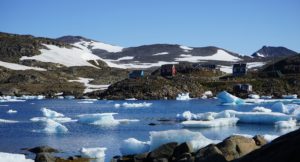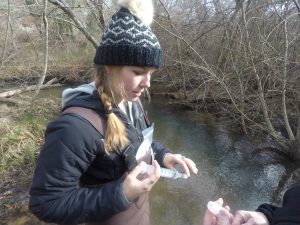Passed in 1970, the National Environmental Policy Act (NEPA) requires U.S. federal agencies to assess the environmental impacts of their proposed actions prior to implementing them. To facilitate this, and to ensure decisionmaking is uniform across government agencies, the law stipulates regulations around the process for conducting these impact assessments. A March ruling from the Council of Environmental Quality (CEQ) removes these regulations, opening up the possibility for regulatory confusion and inconsistency between agencies that ultimately lessens the effectiveness of environmental protections.
Woodwell Climate Research Center submitted a public comment on the ruling, criticizing the move for its potential to hinder coherent decisionmaking based on rigorous science. The comment states:
“NEPA reviews are not an impediment to “major federal actions” but provide an essential, science-based safeguard for ensuring that decisionmaking adequately balances a myriad of interests. This balance is especially critical in areas of the United States where increasingly frequent natural disturbances and extreme events threaten to derail the durability of a proposed federal action.”
The comment speaks to the effectiveness of the existing environmental review process, especially for decisionmaking in Alaska, where construction projects were guided to consider the impacts of permafrost thaw and erosion as part of hydrological and ground assessments, and in forest management plans, where the NEPA review process ensures management strategies are scrutinized with empirical data.
The ruling is considered “interim final” which means it can be put into effect before comments have been considered and is not dependent on public input. Despite this, engaging in the rulemaking process is one critical way Woodwell Climate contributes to environmental policy. It ensures that technical expertise is part of the public record, and provides evidence that can be used in court cases should the ruling or any action based on it be challenged in the future.
The full comment can be read here.
Guest commentary: We must stand together

Falmouth is more than just a picturesque coastal town; it is a vibrant village of discovery built over decades around the pillars of science, education and environmental stewardship. In the same way, the Woods Hole Oceanographic Institution (WHOI), Woodwell Climate Research Center and Marine Biological Laboratory (MBL) are not just esteemed institutions, but integral parts of our community.
Continue reading on The Falmouth Enterprise.
In the Arctic, permafrost plays a crucial role in building infrastructure. However, as the region warms and permafrost thaws, infrastructure is threatened as the ground shifts beneath the built environment. Unfortunately, the full extent of the risks associated with this process is not yet realized, but researchers are working to address this knowledge gap.
Woodwell Climate Associate Scientist, Dr. Anna Liljedahl, along with UConn Department of Natural Resources and the Environment researchers Elias Manos and Assistant Professor Dr. Chandi Witharana developed a method that uses high-resolution satellite imagery and deep machine learning to map Alaskan infrastructure and more accurately project economic risks associated with permafrost thaw. Their findings published in Nature Communications Earth and Environment estimated that the costs of permafrost damage to infrastructure will double under low and medium emissions scenarios by 2050.
“Damages to infrastructure caused by permafrost thaw is on par with the average yearly cost of all natural disasters in the country, yet permafrost thaw is not recognized by the federal government as a natural hazard making it harder for people in Alaska to obtain disaster relief funding,” says Liljedahl.
This study is the latest from Witharana’s research group, which examines the ways satellites can help monitor changes in the Arctic landscape over time. According to Manos, in order to understand the hazards of a changing climate, we need a clear understanding of what’s at risk—in this case, vital structures like buildings and roads.
Permafrost serves as a structural foundation; piles are secured through it and buildings are often designed specifically to help the thermal integrity of this anchor layer. But the structural integrity of the layer, and consequently the structures above, is compromised as the permafrost thaws.
“When the temperature of permafrost starts to increase, piles start to shift out of place, and that’s what we call bearing capacity loss, or decrease in bearing capacity. That was the main hazard that we looked at which impacts buildings,” says Manos. “Then there’s also transportation infrastructure that’s primarily impacted by ground subsidence. When ice-rich permafrost thaws, the ground will cave in and that was the hazard we used to assess the disaster risk for roads.”
Previous studies have made risk estimates based on data from OpenStreetMap (OSM), which is one of the most widely used geospatial data sets available, says Manos. OSM is available for every nation across the globe, and information is updated by volunteers who manually input local data, like buildings, trails, roads, or other kinds of infrastructure, from high-resolution imagery on a global scale. For some regions, like Europe and parts of the United States, the data is accurate, says Manos, but that is not true for all locations. Unfortunately for the Arctic, OSM data is lacking.
“There are several previous risk studies that relied on this incomplete infrastructure data. It all goes back to the fact that infrastructure across the Arctic is not completely mapped, and that’s problematic if you want to understand disasters because you must have the full picture to understand the scale of what is or could potentially be exposed,” says Manos.
To fill in that picture, Witharana’s group developed a method to accurately map infrastructure and permafrost thaw risk called High-resolution Arctic Built Infrastructure and Terrain Analysis Tool (HABITAT). The model uses machine learning and AI to extract road and building information from high-resolution satellite images from the years 2018-2023. They compared the HABITAT data with OSM data to evaluate the new model’s quality and to look for potential misclassifications. Then they added the new information to OSM, nearly doubling the amount of information available for Alaska.
“The sheer amount of infrastructure and buildings that were missing from Open Street Map was, really shocking to me, 47% missing,” says Manos. “Though OpenStreetMap is a powerful volunteer-based resource, it has limitations and that is not a surprise.”
Witharana adds that by combining OSM data with the thousands of sub-meter resolution satellite images provided by the National Science Foundation, along with access to NSF supercomputing infrastructure, it was possible for the researchers to enhance the completeness of these datasets.
“We can see that impact and do better assessments of economic disturbances and risk so we can prepare for whatever policy actions or downstream efforts that are needed,” says Witharana “That’s a major outcome. Overall, the integration of AI and big data sets within our application has helped make useful, actionable products that researchers and communities can use right now.”
Witharana, Liljedahl, and Manos have plans to expand this analysis to account for the entire Arctic region to assess economic losses using a comprehensive infrastructure map.
“Alaska is decades behind the rest of the country in terms of geospatial data readiness. Maps are key for assessments and planning and I think the research community can help with some of that,” says Liljedahl.
Arctic sea ice hits record low for its usual peak growth period

Arctic sea ice had its weakest winter buildup since record-keeping began 47 years ago, a symptom of climate change that will have repercussions globally, scientists said Thursday.
The Arctic reaches its maximum sea ice in March each year and then starts a six-month melt season. The National Snow and Ice Data Center said the peak measurement taken Saturday was 5.53 million square miles (14.33 million square kilometers) — about 30,000 square miles (80,000 square kilometers) smaller than the lowest previous peak in 2017.
That’s a difference about the size of California.
Associate Scientist, Dr. Brendan Rogers has walked in many forests, but primary forests, he says, “just feel different.”
Rogers’ work often takes him to the cool, dark understories of black spruce and pine boreal forests, where he’s learned the subtle markers of a truly old, healthy, stable forest ecosystem.
“Generally cooler, often wetter, the trees are bigger but sparser and more likely to be conifers than shrubs or deciduous broadleaf trees,” says Rogers. “The ground is squishy to walk on, from the build-up of peat-like soils, mosses, and lichens.”
Primary forests are also a critical piece in the climate puzzle. They represent centuries of sequestered carbon, and every year they remain standing these forests continue to pull carbon from the atmosphere and lock it away in their trees and soils. They are also the subject of intense debates in forest management circles because, according to Rogers, despite knowing intuitively when you are standing in a primary forest, quantitatively identifying one is a tricky task.
That fact hasn’t deterred Rogers and his collaborator Dr. Brendan Mackey at Griffith University, from their work to identify and map metrics indicative of primary forests. In a joint project launched in 2018, Rogers and Mackey created an index of one such metric— forest stability.
Measuring forest stability
Forest stability is a measure of a forest’s resistance to disturbances, both manmade and natural. A stable forest has a high level of ecosystem integrity—a holistic term referring to the combination of ecosystem structure, function, species composition, and adaptive capacity. Stability reflects the ability of a forest to maintain all of those elements in the face of disturbance.
To quantify stability, Rogers and Mackey isolated two metrics that correlate heavily with integrity in forests— “greenness” and water stress. Greenness, also known as the fraction of photosynthetically active radiation (fPAR), indicates the amount of thriving, photosynthesizing plants. Water stress is an index of anomalies in vegetation moisture, indicating an area is dryer than usual. Both of these metrics can be remotely derived from satellites and, when combined with additional data, form an index of overall stability level.
This index was first tested by a postdoctoral scientist at Woodwell Climate, Dr. Tatiana Shestakova, who pulled data from NASA’s MODIS satellite sensor to map stability in sample regions in the Kayapo Indigenous Territory in the Brazilian Amazon and southern Taiga region of Siberia. After testing the model, Rogers, Mackey, and Shestakova expanded it to map stability across the entirety of Ontario, Quebec, boreal Siberia, and the Amazon rainforest.
The studies used a method called a time series analysis, which compares satellite data stretching back to 2002 to determine whether a forest had experienced a large-scale disturbance, reducing vegetation greenness and increasing water stress and thus lowering overall stability. These insights were only possible due to the long, consistent dataset produced by MODIS.
“It can be a little bit dicey to assess stability on shorter time scales,” says Rogers. “Because when you work with remote sensing data, forests can fluctuate year to year and sometimes you can’t completely eliminate things like cloud contamination or other errors from the data, so a longer time series helps smooth the data and lets you see the true patterns.”
Prioritizing protection for primary forests
These maps of stability have a crucial role to play in informing forest management policy.
“We’re trying to analyze and spatially map the ecological condition of forests,” says Mackey. “Because this information is needed to help guide where investments for forest protection and restoration go and how they should be prioritized.”
For a long time, Mackey says, management conversations did not distinguish between types of forests, lumping monoculture tree plantations into the same category as ancient natural forests, despite the vast differences in their carbon storage, biodiversity, ecosystem benefits, and overall resistance against disturbances.
“We weren’t seeing the forest for the wood,” Mackey jokes.
Quantifying a characteristic like stability makes it easier for managers to see the difference between the two, identify the forests best able to provide myriad ecological benefits, and ideally, prioritize those for protection.
Mackey uses the example of woodland caribou in Canada, which are considered a threatened species. These animals require large areas of intact primary forest to support successful populations. Overlaying forest stability on top of caribou habitat maps can help decisionmakers narrow in on the largest, highest-stability tracts of forest as top priority for conservation.
According to Rogers, a future goal would be to eventually link maps of forest stability with carbon estimates in order to create forest protection plans with climate mitigation in mind. Research in primary forests has shown they continue to sequester carbon year over year, even though tree growth has tapered off. With primary forests in many places under intense political and economic pressures, it will become even more important to demonstrate the many co-benefits of protecting the earth’s stable forests.
“There’s no forest anywhere that isn’t threatened,” says Mackey. “Development, infrastructure, roading, damming, logging, clearing for agriculture. It’s happening everywhere.”
Stable forests are resilient forests
Tracking stability of forests also allows us to approach a much harder-to-define characteristic of primary forests—resilience.
Stability and resilience go hand in hand, though they are not the same thing. While resilience speaks to an ecosystem’s adaptive capacity or its ability to recover to its original state after some disturbance, stability is a measure of resistance, which is why it correlates so highly to primary forests that haven’t experienced any recent large-scale disturbance.
“If the stability index is showing recovery, then there’s obviously some resilience happening, but beyond that, primary forests tend to be more resistant to certain disturbances,” says Mackey. “Sometimes resistance is better even than being resilient. You’re not destroyed in the first place.”
Highly stable forests do tend to have better adaptive capacities as well, which is why they are so critical to protect.
“By and large,” says Rogers, “forests are resilient.” The stable ones can handle disruptions, and if you leave them to recover they will do just that, as he and Mackey have seen in the data.
But resilience is not infinite. If you hit too hard too fast—overlapping disturbances on an already unstable forest—you can overwhelm its resilience. Fires, larger and more frequent as a result of climate change, have already begun to override boreal forests’ adaptation. And there are more changes coming as the planet continues heating up.
For now, at least, Rogers says, “resilience is still largely what we see out there.”
This town on the Cape is a hub for climate scientists. Under Trump, its local economy is shaking.
The small community on the upper Cape has been a company town for environmental scientists for over a century.

An unease has settled over this small-town community of scientists lately like the fog that crept across the upper Cape on a recent March morning.
It’s difficult to see around the bend: Will the scientists have a job next month? Will their life’s work be halted? Will their colleagues flee abroad, seeking funds and political support for their research?
“Science in Woods Hole is most definitely under threat,” said Max Holmes, president and CEO of Woodwell Climate Research Center.
“We don’t know what the future holds, but we’re not going to just sit back and wait,” Holmes said. “We’re going to use our voice.”
Continue reading on The Boston Globe.
How rolling back EPA regulations could impact New England air and water

Researchers and advocates in New England say the federal government’s plans to reconsider environmental rules could have long-lasting effects on public health, air pollution and ecosystems in Massachusetts and across the region.
The Environmental Protection Agency this week announced a long list of regulations it expects to review including those that limit factory pollution, vehicle emissions and wastewater from coal-fired power plants.



